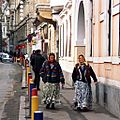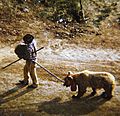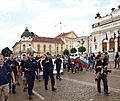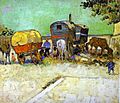Romani people facts for kids
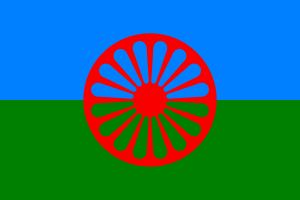
Romani flag created in 1933 and accepted by the 1971 World Romani Congress
|
|
| Total population | |
|---|---|
| 2–20 million | |
| 1,000,000 estimated with Romani ancestry | |
| 800,000 | |
| 750,000–1,100,000 (1.87%) | |
| 619,007 (3.3%) | |
| 500,000–2,750,000 (3.78%) | |
| 350,000–500,000 | |
| 325,343–750,000 (10.33%) | |
| 309,632–870,000 (8.8%) | |
| c. 300,000 | |
| 225,000 (0.36%) | |
| 205,007–825,000 (0.58%) | |
| 147,604–600,000 (8.23%) | |
| 120,000–180,000 (0.3%) | |
| 111,000–300,000 (2.7%) | |
| 105,000 (0.13%) | |
| 105,738–490,000 (9.02%) | |
| 100,000–110,000 | |
| 53,879–197,000 (9.56%) | |
| 50,000–100,000 | |
| 47,587–260,000 (0.57%) | |
| 40,000–52,000 (0.49%) | |
| 40,000–50,000 (0.57%) | |
| 36,000 (2%) | |
| 32,000–40,000 (0.24%) | |
| 22,435–37,500 (0.84%) | |
| 17,049–32,500 (0.09%) | |
| 16,975–35,000 (0.79%) | |
| 15,850 | |
| 12,778–107,100 (3.01%) | |
| 8,864–58,000 (1.54%) | |
| c. 8,000 | |
| 8,301–115,000 (3.59%) | |
| 7,316–47,500 (0.5%) | |
| 7,193–12,500 (0.56%) | |
| 5,255–80,000 | |
| 5,251–20,000 (3.7%) | |
| Languages | |
| Romani language, Para-Romani varieties, languages of native regions | |
| Religion | |
| Predominantly Christianity Islam Shaktism tradition of Hinduism Romani mythology |
|
| Related ethnic groups | |
| Dom, Lom, Domba; other Indo-Aryans | |
The Romani people, often called Roma, are a group with a unique history. They traditionally traveled a lot. Most Romani live in Europe and the Americas today. Their ancestors came from northern India, specifically the Rajasthan, Haryana, and Punjab areas.
Scientists have studied Romani genes. These studies suggest that the Romani people came from one group. This group left northwestern India about 1,500 years ago. Over 70% of Romani males share a special genetic line. This line seems to be found only in the Romani people.
The Romani are a scattered people. But most of them live in Europe. You can find large groups in Central, Eastern, and Southern Europe. This includes countries like Turkey, Spain, and Southern France. The Romani started their journey from northern India. They arrived in Mid-West Asia and Europe about 1,000 years ago.
The Romani are sometimes called Gypsies in English. However, many Romani people find this word offensive. This is because it has been used in a negative way. In 1888, the Gypsy Lore Society began publishing a journal. This journal aimed to correct false ideas about the Romani way of life.
Romani People Around the World
Since the 1800s, some Romani have moved to the Americas. About one million Romani live in the United States. Another 800,000 live in Brazil. Most of their families came from Eastern Europe in the 1800s. Brazil also has Romani people whose ancestors were sent there. They were deported by the Portuguese Empire during the Portuguese Inquisition. After the late 1800s, Romani people also moved to other countries. They went to South America and Canada.
In February 2016, a big meeting for Romani people happened. It was called the International Roma Conference. India's Minister of External Affairs said something important. He stated that Romani people are "children of India." The conference suggested that the Government of India should recognize Romani people. They asked India to see them as part of the Indian diaspora. This means they are Indian people living in other countries.
Romani Language and Culture
The Romani language has many different forms. These are called dialects. More than two million people speak Romani dialects. The total number of Romani people is much higher. Many Romani also speak the main language of their country. Sometimes, they speak a mixed language. This language combines the local language with a Romani dialect. These mixed languages are sometimes called Para-Romani.
Images for kids
-
Three Finnish Romani women in Helsinki, Finland, in 1930s
-
Gypsies camping. Welsh Romanies near Swansea, 1953
-
Two Gypsies by Francisco Iturrino
-
A Roma makes a complaint to a local magistrate in Hungary, by Sándor Bihari, 1886
-
An 1852 Wallachian poster advertising an auction of Romani slaves in Bucharest
-
Sinti and other Romani about to be deported from Germany, 22 May 1940
-
Münster, Sebastian (1552), "A Gipsy Family", The Cosmographia (facsimile of a woodcut), Basle
-
Nomadic Roma family traveling in Moldavia, 1837
-
Christian Romanies during the pilgrimage to Saintes-Maries-de-la-Mer in France, 1980s
-
Two Orthodox Christian Romanies in Cluj-Napoca, Romania
-
Romani and bear (Belgrade, Banovo brdo, 1980s)
-
Gypsy fortune-teller in Poland, by Antoni Kozakiewicz, 1884
-
Muslim Romanies in Bosnia and Herzegovina (around 1900)
-
Street performance during the Khamoro World Roma Festival in Prague, 2007
-
Deportation of Roma from Asperg, Germany, 1940 (photograph by the Rassenhygienische Forschungsstelle)
-
Distribution of the Romani people in Europe (2007 Council of Europe "average estimates", totalling 9.8 million)
-
Antiziganist protests in Sofia, 2011
-
Paris Bordone, The Rest on the Flight into Egypt c. 1530, Elizabeth, at right, is shown as a Romani fortune-teller
-
August von Pettenkofen: Gypsy Children (1885), Hermitage Museum
-
Mihály Munkácsy: Gypsy Family (1884, oil on canvas)
-
Vincent van Gogh: The Caravans – Gypsy Camp near Arles (1888, oil on canvas)
-
Meg Merrilies from Walter Scott's novel Guy Mannering (1815)
See also
 In Spanish: Pueblo gitano para niños
In Spanish: Pueblo gitano para niños














